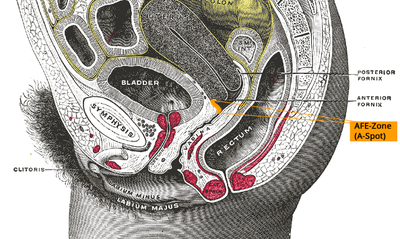A point



A point stands for the English name Anterior Fornix Erogenous Zone , AFE zone for short , and represents an area in the vagina of women that is sensitive to stimulation in some women. It belongs to the erogenous zones . According to the gynecologist Chua Chee Ann from Malaysia , the A-spot is more sensitive to stimuli than the also controversial G-spot .
anatomy
According to the gynecologist Josef von Halban , the so-called Halban's fascia or septum vesicovaginale is located between the vagina and the urinary bladder ; Provision of Krause bodies and pseudo-corpuscular nerve endings. When this connective tissue space is stimulated, vasoconstriction and pleasant erotic sensations occur.
According to Chua Chee Ann, the A-point is located in the anterior wall of the vagina, roughly between the G-spot and the cervix . Accessibility depends on the position or the abnormal position of the uterus. The A point was described by him at the Asian Congress of Sexology in 2003. Ann emphasized the importance for women with severe pain during intercourse due to lack of moisture. When the zone is stimulated, the lubrication by the Bartholin's glands increases . In addition, according to the gynecologist, a third of women react to the stimulation of the A-point with multiple orgasms.
If the A-point in the rear, upper vaginal vault is touched, you can activate the erogenous zone with gentle but even manual pressure from the inside out, towards the abdominal wall. The shoveling finger movement, in the sense of a "come here movement", should be fed back in the sense of an attention guided by " feedback " .
In order to stimulate the A-point through penile penetration during vaginal intercourse , on the one hand a corresponding level of sexual arousal is necessary in the woman and, on the other hand, the penetration depth or angle of the penis is important. This can be improved through appropriate sex positions, but also through improved technology. Sexual intercourse is usually caused by a rhythmic back and forth movements of the penis or the female genitalia up to orgasm. For optimal A-point stimulation, it is advisable to reinforce this intravaginally with a small, strong, deep thrust after every deep forward movement. This will penetrate the penis about another 1–2 cm deeper. A direct impact on the cervix can u. U. be perceived as unpleasant. The position of the uterus , whether anteflexed or retroflexed, can be significant and may then require correction through appropriate sex positions or the perfect angle for the penis and vagina.
So it can be B. for the sexual partner in the a tergo position it can be helpful to raise the buttocks more and kneel into a stronger hyperlordosis in the lumbar spine. This is especially true for women who have a so-called retroflected uterine position. This shifts the angle more favorably for the penetrating penis so that the Anterior Fornix Erogenous Zone (AFE zone) can be better reached.
Chua Chee Ann claims to have found the A-spot by chance during an examination, and then tested the reaction to corresponding stimulation in other women. Several came to orgasm spontaneously .
See also
- Clitoris (C point)
literature
- Chua Chee Ann: A proposal for a radical new sex therapy technique for the management of vasocongestive and orgasmic dysfunction in women: The AFE Zone Stimulation Technique. In: Sexual and Marital Therapy. 12, 1997, p. 357, doi : 10.1080 / 02674659708408179 .
- RJ Levin: The physiology of sexual arousal in the human female: a recreational and procreational synthesis. In: Archives of sexual behavior. Volume 31, Number 5, October 2002, pp. 405-411, PMID 12238607 .
- JM Schober, D. Pfaff: The neurophysiology of sexual arousal. In: Best practice & research. Clinical endocrinology & metabolism. Volume 21, Number 3, September 2007, pp. 445-461, doi : 10.1016 / j.beem.2007.04.006 , PMID 17875491 (review).
Web links
- Interview with: DR. CHUA CHEE ANN MD (PDF file; 38 kB)
- Biodata: Dr Chua Chee Ann (PDF file; 1.67 MB)
Individual evidence
- ↑ To the front, i.e. towards the abdomen, ventrally or below the pubic bone . Anatomical proximity to the overlying urinary bladder .
- ↑ Minh MH, Smadja A, De Sigalony JPH, Aetherr JF .: Role du fascia de Halban dans la physiologie orgasmique feminime. Cahiers de Sexuol Clin 1981; 7: 169.
- ↑ Anteflexio uteri, the natural forward flexion of the uterus. A retroflexio uteri is a backward sloping uterus that can be either mobile or fixed. Schematic representation of ante- and retroflexion of the uterus [1]
- ↑ Angle of the body of the uterus in relation to the cervix (flexio) [2]
- ↑ Usually the anatomical position of the uterus is such that the anterior wall of the uterus points to the adjacent (belly located) urinary bladder , while the posterior wall is oriented towards the rectum . This is called anteflexio , or anteflexio uteri , i.e. the natural forward flexion of the uterus. A retroflexio uteri is a backward sloping uterus that can be either mobile or fixed. Schematic representation of ante- and retroflexion of the uterus [3] [4]